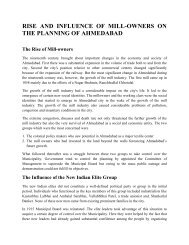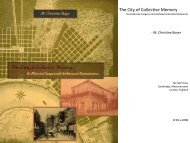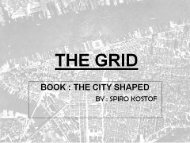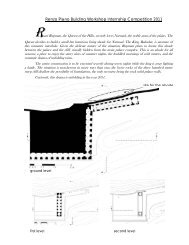the City Edge
the City Edge
the City Edge
Create successful ePaper yourself
Turn your PDF publications into a flip-book with our unique Google optimized e-Paper software.
ANUJA KANANI<br />
1404<br />
THE CITY ASSEMBLED:<br />
by SPIRO KOSTOF<br />
THE CITY EDGE
INTRODUCTION<br />
“ cities are too particular as phenomena- specific to moments in time<br />
and to <strong>the</strong> alterations of site and culture- to be pinned down by<br />
absolute taxonomies”<br />
“ urbanism as a process- <strong>the</strong> many ways in which a city‟s physical<br />
frame is adjusted according to changing contingencies” – spiro<br />
kostof.<br />
this book looks at <strong>the</strong> factors affecting change and modification of<br />
urban form, what elements constitute it, how <strong>the</strong>y assemble toge<strong>the</strong>r<br />
to weave <strong>the</strong> pattern of urban fabric.<br />
The review attempts to study <strong>the</strong> chapter on <strong>the</strong> <strong>City</strong> <strong>Edge</strong>. It takes<br />
into account historical, topographical, political, socio-cultural factors<br />
which brought about a change in <strong>the</strong> defined city edge over time.<br />
THE CITY EDGE
The <strong>City</strong> <strong>Edge</strong><br />
This chapter looks at <strong>the</strong> following broad <strong>the</strong>mes:<br />
a) preliminaries- <strong>the</strong> birth of <strong>the</strong> edge, <strong>the</strong> ritualistic annotations attached to<br />
<strong>the</strong> edge in history, and its meaning.<br />
b) The walled edge- nature of physical boundary, its evolution in time and<br />
place, factors that cause modifications, its consequent impact on <strong>the</strong> urban<br />
fabric.<br />
c) Meeting <strong>the</strong> water- <strong>the</strong> fluid edge, harbour towns, how do port cities differ<br />
from in land cities, nature of such a geographical edge.<br />
d) On <strong>the</strong> periphery-<strong>the</strong> changes in physical form of <strong>the</strong> edge, its political and<br />
social repurcussions, formation of suburbs, industrial regions.<br />
e) The open city- dissolution of <strong>the</strong> hard edge, <strong>the</strong> idea of a fuzzy boundary,<br />
extensions to city, engulfing <strong>the</strong> surroundings.<br />
f) The soft edge of suburbia- nature of suburbs, <strong>the</strong> growth pattern, new forms<br />
of urbanization, formation of complete communities at <strong>the</strong> edge, called<br />
“edge cities”.<br />
THE CITY EDGE
The Walled <strong>Edge</strong><br />
<strong>the</strong> earliest cities had no need for walls.<br />
Most of <strong>the</strong> time, <strong>the</strong> natural<br />
topography of <strong>the</strong> land was defense<br />
enough. Border cities had some sort of<br />
fortifications but o<strong>the</strong>rwise, walls were<br />
more a matter of allegiance than<br />
defense.<br />
The walls were dispensed with when<br />
<strong>the</strong> political power was strong and<br />
wanted to show off its glory by <strong>the</strong>ir<br />
removal, such as <strong>the</strong> Ottoman empire.<br />
In absence of <strong>the</strong>ir own defenses,<br />
settlements depended on a central<br />
fortified zone, to escape to when in<br />
danger. O<strong>the</strong>r means were to build <strong>the</strong><br />
outermost houses in a tight ring of<br />
walls with a windowless periphery.<br />
The presence of a definite physical<br />
boundary limited <strong>the</strong> city‟s expansion,<br />
also it made it effective in protecting<br />
market privileges.<br />
THE CITY EDGE<br />
The Catal huyuk, Turkey.: note <strong>the</strong> tight<br />
clustered formation of houses with one continuous<br />
wall<br />
The Chaco culture, New Mexico. Urban form as<br />
measure of defense
WALL – its features<br />
Walls need room. The base of earlier<br />
walls meant for defense was as wide as<br />
12- 16m across.<br />
They were supplemented by a ditch ,<br />
which becomes a more effective defense<br />
mechanism if its filled with water and<br />
becomes a moat.<br />
Earth excavated is used in building <strong>the</strong><br />
rampart , <strong>the</strong> proportions of <strong>the</strong> two are<br />
closely related.<br />
THE CITY EDGE<br />
Sketches of proportion<br />
between ditch and<br />
wall
Usually defense circuits are circular<br />
:shortest defense line around a maximum<br />
area required few defenders than right<br />
angle or broken outlines.<br />
Transition from circular to rectangular:<br />
early walls were massive affairs, made<br />
from compressed earth. Around <strong>the</strong> 14 th<br />
century <strong>the</strong> walls were faced with brick or<br />
stone. The use of modular units such as<br />
bricks gave rise to rectangular circuits<br />
from <strong>the</strong>n onwards.<br />
Primitive walls used wooden barriers in<br />
<strong>the</strong> form of stockades : large pointed oaks<br />
with intermittent embrasures. Later<br />
additions included <strong>the</strong> towers for cannon<br />
at <strong>the</strong> corners and at <strong>the</strong> gates as artillery<br />
was invented.<br />
The shortest defense line is circular:<br />
hence <strong>the</strong> first circuits were designed<br />
circular… morever, it was tracing <strong>the</strong><br />
land contours, around a hill.. Which<br />
usually formed a circular path.
A<strong>the</strong>ns : 18 th century depictions<br />
A citadel was <strong>the</strong> only fortification in <strong>the</strong> 5 th century bc. The outer wall came in <strong>the</strong> 12 th century, which was<br />
modified in <strong>the</strong> 17 th century ad.<br />
THE CITY EDGE
The Nature of <strong>the</strong> Wall – <strong>the</strong>ir evolution in time<br />
The exact nature of <strong>the</strong> walls of a medieval town or city would depend on<br />
<strong>the</strong> resources available for building <strong>the</strong>m, <strong>the</strong> nature of <strong>the</strong> terrain and <strong>the</strong><br />
perceived threat.<br />
The walls were modified to suit new tactics, weapons and siege techniques<br />
Primitive edge: closely knit<br />
fabric surrounded with fields<br />
and wilderness.<br />
THE CITY EDGE<br />
Simple single curtained wall
Masonry walls consist of a single or a double curtain, of varying thickness<br />
and design. In medieval Europe, <strong>the</strong> idea of a double curtain comes around<br />
14 th century. The sheltered belt was used by <strong>the</strong> besieged to ga<strong>the</strong>r and stage<br />
unexpected sorties.<br />
<strong>the</strong> wall will have had an internal and an external pomoerium. This was a<br />
strip of clear ground immediately inside or outside <strong>the</strong> wall.<br />
double curtained wall : in between space is called <strong>the</strong> “killing ground” where<br />
<strong>the</strong> besieged get a clear target of <strong>the</strong>ir attackers<br />
THE CITY EDGE
A star fort or trace italienne is a fortification in <strong>the</strong> style that evolved during<br />
<strong>the</strong> age of black powder, when cannons came to dominate <strong>the</strong> battlefield,<br />
and was first seen mid-15th century in Italy.<br />
Star fortifications were fur<strong>the</strong>r developed in <strong>the</strong> late fifteenth and early<br />
sixteenth century in response, primarily, to <strong>the</strong> French invasion of <strong>the</strong> Italian<br />
peninsula. The French army was equipped with new cannons and bombards<br />
that were able to easily destroy traditional fortifications built in <strong>the</strong> Middle<br />
Ages.<br />
Towards <strong>the</strong> 17 th century, <strong>the</strong> bastioned wall with its associated features<br />
such as pincers, ravelins etc became a must, more out of a political stunt of<br />
show of power ra<strong>the</strong>r than need for defense. The city was completely,<br />
cruelly cut off from <strong>the</strong> countryside. This thwarted <strong>the</strong> growth of European<br />
cities to a large extent.<br />
Fortification plan<br />
THE CITY EDGE<br />
Bourtange fortification, restored to 1750 situation,<br />
Groningen, Ne<strong>the</strong>rlands
Around <strong>the</strong> wall: <strong>the</strong> pomoerium<br />
Fort walls in Carcassone, France. :<br />
Ramps for troop movement.<br />
Walls in Avila, Spain.<br />
THE CITY EDGE<br />
In Constantinople, <strong>the</strong> invaders<br />
had to first traverse a wide moat,<br />
which was met by a terrace 15 m in<br />
width which separated it from <strong>the</strong><br />
lower outer wall. Then came<br />
ano<strong>the</strong>r terrace (called peribolos )<br />
and <strong>the</strong>n <strong>the</strong> high inner circuit of<br />
<strong>the</strong> walls.<br />
The space outside <strong>the</strong> walls was<br />
called <strong>the</strong> extramural zone, and <strong>the</strong><br />
space between <strong>the</strong> built form and<br />
<strong>the</strong> inner most wall was <strong>the</strong> intra<br />
mural zone.<br />
This space usually used for taking<br />
<strong>the</strong> troops to <strong>the</strong> top of <strong>the</strong> walls.<br />
In Ancient Roman cities, <strong>the</strong><br />
ceremonial procession route<br />
cutting through <strong>the</strong> heart of <strong>the</strong><br />
city, apart from ritual associations,<br />
primarily served <strong>the</strong> purpose of<br />
troop movement.
Change in <strong>the</strong> nature of walls : <strong>the</strong> intramural<br />
zone.<br />
As <strong>the</strong> power of cannons grew during <strong>the</strong> 16th and 17th century,<br />
medieval walls became obsolete as <strong>the</strong>y were too thin to offer any<br />
realistic protection against prolonged bombardment. Most walls<br />
were torn down, <strong>the</strong> material was used in building of towers.<br />
The intramural zone was <strong>the</strong> least desirable area to build. This<br />
gave opportunity for squatter settlements and makeshift shanties<br />
come against <strong>the</strong> wall.<br />
In China, <strong>the</strong> earlier walls that were built out of earth were<br />
massive affairs. The poor built shelters attached to it, as well as<br />
carved niches which were cave-like in nature.<br />
Walls in Chang „an, china. Artillery platforms built in<br />
between <strong>the</strong> towers- largely increased unbuilt space<br />
between city and <strong>the</strong> walls. .<br />
THE CITY EDGE<br />
<strong>City</strong> walls in Beijing, China: extremely massive.
The change within: Intramural<br />
Even <strong>the</strong> rich were attracted to <strong>the</strong> intramural zone: There were multiple<br />
functions that <strong>the</strong> bastioned wall served, if we take a look through <strong>the</strong> pages<br />
of history, from formation of suburban districts to <strong>the</strong> building of pleasure<br />
gardens and palaces on top of <strong>the</strong>m. The Zwinger palace in <strong>the</strong> city of<br />
Dresden in Germany is one such example.<br />
In Paris, <strong>the</strong> development of boulevards was a consequence of <strong>the</strong> walls<br />
being brought down, and availability of a large unbuilt space at <strong>the</strong> city‟s<br />
edge.<br />
THE CITY EDGE<br />
Berlin,<br />
1720.<br />
inside <strong>the</strong><br />
wall are a<br />
school,<br />
church,<br />
garrison<br />
area.<br />
View of boulevards in Paris
THE CITY EDGE<br />
pleasure walkways and gardens built on top of <strong>the</strong> walls<br />
and inside <strong>the</strong>m, in <strong>the</strong> city of Lucca, Italy.
The change without: Extramural zone<br />
<strong>the</strong> fringe belt<br />
The unbuilt zone in between <strong>the</strong> curtain walls and outside it, was occupied by<br />
lesser important urban functions and sects of society such as <strong>the</strong> artisans, <strong>the</strong><br />
tannery, <strong>the</strong> horse and cattle markets and so on. Also contained in it were<br />
religious buildings which came up too late for <strong>the</strong> extremely dense core.<br />
Geographers call this zone as <strong>the</strong> “urban fringe belt”. It stands for a collection<br />
of mixed land uses, with large scale and low density built pattern which is<br />
drastically different from <strong>the</strong> tightly knit urban fabric of <strong>the</strong> core.<br />
As <strong>the</strong> city grows, new fringe belts are developed fur<strong>the</strong>r out, in patterns which<br />
are not necessarily concentric manner or sequential growth. The development<br />
and growth pattern of fringe belts are irregular in most European city plans.<br />
Stages of development of fringe belts: one leapfrogging <strong>the</strong> o<strong>the</strong>r- creating irregular pattern of growth<br />
THE CITY EDGE
Map of Siena,Italy : late 17 th century ad. The urban fringe outside <strong>the</strong> original city core is<br />
obviously seen.<br />
THE CITY EDGE
above: Early map of A<strong>the</strong>ns,<br />
date unknown.<br />
THE CITY EDGE<br />
above: Plan of A<strong>the</strong>ns , 1848 Ad: dissolution of<br />
<strong>the</strong> walls, use of <strong>the</strong> grid, planned extensions<br />
are obvious. There are central streets<br />
connecting to <strong>the</strong> suburban development.<br />
Left: plan of A<strong>the</strong>ns, before 1800 AD. Showing how <strong>the</strong> densely<br />
urbanized section of <strong>the</strong> city reached to <strong>the</strong> north <strong>the</strong> area of <strong>the</strong><br />
current <strong>City</strong> Hall; to <strong>the</strong> nor<strong>the</strong>ast, Stadiou ave. (where <strong>the</strong> 18th<br />
century wall was built). The streets of <strong>the</strong> city are <strong>the</strong> same<br />
irregular thoroughfares used today in <strong>the</strong> historic center
The <strong>City</strong> Gates<br />
Boubounistra Gate in<br />
1819, A<strong>the</strong>ns<br />
Roman Agora Gate in 1762<br />
THE CITY EDGE<br />
Gate of Roman Forum<br />
in 1819,A<strong>the</strong>ns<br />
The A<strong>the</strong>ns market ca.<br />
1799<br />
They funnelled <strong>the</strong> highway traffic<br />
into <strong>the</strong> city. Markets occurred<br />
near <strong>the</strong>m.<br />
Noble families who owned land on<br />
both sides of <strong>the</strong> wall, used to<br />
build fortified residences <strong>the</strong>re.<br />
The protection and maintainence<br />
of <strong>the</strong> towers and gates adjacent to<br />
<strong>the</strong>m was entrusted to <strong>the</strong> nobles.<br />
The gates were <strong>the</strong> entry point, <strong>the</strong><br />
landmark of a city. Thus <strong>the</strong>y<br />
received great architectural care.<br />
The conflict between defense<br />
(obstruction) and access had to be<br />
taken care of meticulously. In<br />
china, <strong>the</strong> gates were usually at a<br />
“t” intersection with through<br />
streets, not directly linked to <strong>the</strong><br />
street network.
Mural traces<br />
First, <strong>the</strong> city edge had defined as a<br />
hard physical wall, which got<br />
modified to <strong>the</strong> development of<br />
urban fringes, to dissolution of a<br />
hard edge to a subtle , notional<br />
edge. Traces of <strong>the</strong> wall always<br />
remained in some form or o<strong>the</strong>r.<br />
In European cities, ring strasses, or<br />
outer ring roads occurred where<br />
<strong>the</strong> walls once stood.<br />
Sometimes this huge unbuilt space<br />
was sold for construction. The land<br />
was divided into lots and<br />
converted to profitable<br />
commodities.<br />
In cities with “organic” plans, <strong>the</strong><br />
gates occur as a convergence point<br />
of internal streets, with 2 or 3<br />
external streets outside it. Irregular<br />
constellations of streets suggest <strong>the</strong><br />
presence of a defensive circuit.<br />
THE CITY EDGE
On <strong>the</strong> periphery<br />
A prosperous and safe city will attract outsiders to<br />
its periphery who want to use its advantages. Also,<br />
sometimes, <strong>the</strong>re is a spill out from <strong>the</strong> inner dense<br />
core to <strong>the</strong> periphery. Thus are born <strong>the</strong> suburbs.<br />
The phenomenon is as ancient as cities. In Assyria,<br />
<strong>the</strong>re existed Karum,a colony of merchants just<br />
outside <strong>the</strong> city.<br />
Passing tradesmen in time would permanently<br />
plant <strong>the</strong>mselves in <strong>the</strong> shadow of <strong>the</strong> city walls,<br />
near <strong>the</strong> gates, and form a new life , and create a<br />
new urban form.<br />
There is ano<strong>the</strong>r distinctive phenomenon of<br />
suburban growth which begins as new satellite<br />
centres around a city, but not directly attached to it.<br />
There is also <strong>the</strong> case of ribbon development,<br />
wherein <strong>the</strong> suburbs grow in a concentric fashion<br />
outwards.<br />
THE CITY EDGE<br />
Karum, trading colony at<br />
Kanesh, Asyyria.
Planned extensions<br />
Medieval cities in Europe who seem to have organic growth patterns,<br />
sometimes have been planned in stages, according to <strong>the</strong> street patterns.<br />
There were built outer ring of walls, and in cases such as Florence and Siena,<br />
but took centuries to reach it. After <strong>the</strong> 17 th century, large planned estates,<br />
with parks and monuments occurred outside <strong>the</strong> periphery.<br />
In <strong>the</strong> industrial age, <strong>the</strong> privileged refused to move out of <strong>the</strong> historic core,<br />
which resulted in <strong>the</strong> urban extensions becoming exile zones with workers<br />
and industries girdling <strong>the</strong> city.<br />
THE CITY EDGE<br />
Paris: 18 th century AD.<br />
Outside <strong>the</strong> tight ring of <strong>the</strong> walls<br />
<strong>the</strong> suburbs start, towards <strong>the</strong><br />
east. A ring road encircling <strong>the</strong><br />
space of <strong>the</strong> walls can be seen<br />
clearly.
Plan of Friedrichstadt, Germany:<br />
notice <strong>the</strong> grid formation in <strong>the</strong> first<br />
one, showing <strong>the</strong> planned suburbs<br />
immediately outside <strong>the</strong> star shaped<br />
bastioned wall.<br />
THE CITY EDGE<br />
Plan of Friedrichstadt: 1720 AD. Detail.<br />
Strasbourg, Germany: <strong>the</strong> core is rectangular, wherein <strong>the</strong><br />
ca<strong>the</strong>dral is built. A trading suburb grew outside <strong>the</strong> walls to<br />
<strong>the</strong> southwest. centred on a major market street.
CONCLUSIONS<br />
The walled edge was not just a physical entity, but a<br />
definition of <strong>the</strong> city‟s existence, <strong>the</strong> extent of its<br />
power, <strong>the</strong> meaning of its friendship with o<strong>the</strong>r<br />
cities. This edge later continued to get redefined in<br />
o<strong>the</strong>r forms; traces of it always remained in <strong>the</strong><br />
footprint of a city, in its roads, layout, cultural<br />
associations to <strong>the</strong> edge. The boundary whe<strong>the</strong>r<br />
concrete or notional, always made a city, a city.<br />
THE CITY EDGE
















